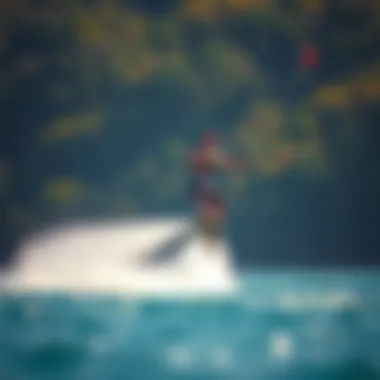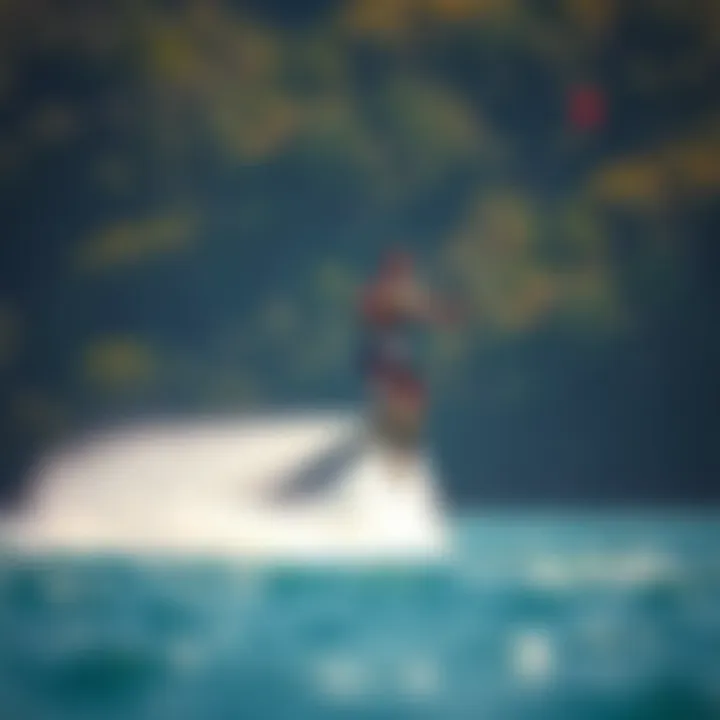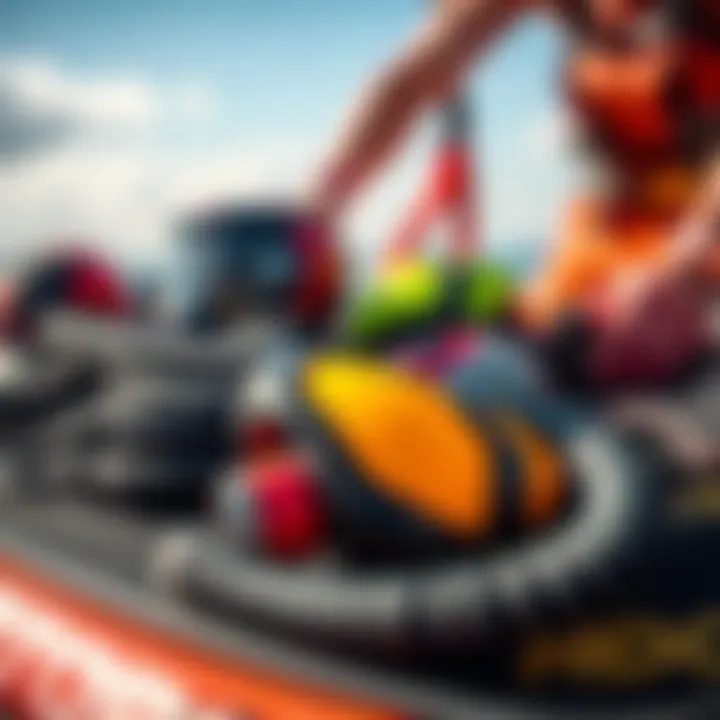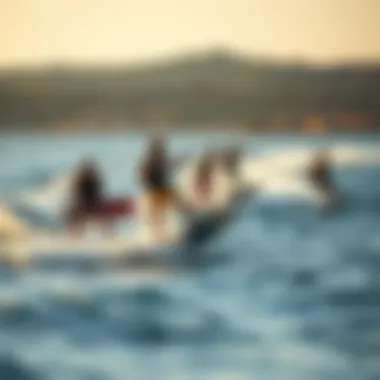Discovering Hydro Wakeboarding: A New Water Sport Adventure


Gear and Equipment
When diving into the world of hydro wakeboarding, understanding the essential gear is crucial for both novices and seasoned riders. Unlike traditional wakeboarding, hydrofoils enable riders to glide above the water's surface, providing a thrilling experience that is hard to replicate. Below is a breakdown of the equipment you will need to hit the water with confidence.
Essential Hydro Wakeboarding Gear for Beginners
- Hydrofoil Board: This is the centerpiece of your gear. Hydrofoil boards come in various sizes, typically ranging from 5 to 7 feet. A beginner may want to choose a slightly larger board for improved stability.
- Foil Setup: The hydrofoil consists of a mast and wings. The mast usually ranges from 24 to 36 inches. For beginners, a shorter mast might provide better control and ease of use.
- Safety Gear: While it might be tempting to skip safety gear, wearing a well-fitted life jacket and helmet is essential. Should a fall occur, having the right protection can prevent serious injuries.
- Wetsuit: Depending on your location and comfort, a wetsuit will help keep you warm. Neoprene suits come in different thicknesses, suitable for various water temperatures.
- Wakeboard Rope: It's not just for pulling you along; a good quality wakeboard rope allows better control and handling as you ride through the water.
- Boat or Personal Watercraft: To start hydro wakeboarding, you'll need a boat that can create a towable wake. Many enthusiasts opt for specialized wake boats that deliver a clean wake for a better experience.
Advanced Equipment for Experienced Riders
As you advance to higher-level hydro wakeboarding, consider upgrading your gear:
- Advanced Hydrofoil Board: Look for a lightweight carbon fiber body that offers improved performance and maneuverability.
- Specialized Wings: Depending on your riding style, experimenting with various wing sizes can have dramatic effects on your speed and stability.
- Custom Ropes: A shorter, specific length of rope tailored to your preferred riding style can enhance your ability to perform tricks.
- Bindings: Upgrading to a more supportive binding system allows for a better fit and enhances control during jumps and turns.
"Hydro wakeboarding is a blend of finesse and adventure; proper gear makes all the difference in mastering the sport."
Techniques and Tips
With the right gear in hand, let's shift gears and look at techniques and safety practices that can enhance your hydro wakeboarding experience. Understanding the proper techniques can help you gain confidence and unleash the full potential of this thrilling sport.
Safety Practices for Hydro Wakeboarding
Safety doesn't take a backseat in hydro wakeboarding. Key practices to follow include:
- Always ride with a buddy. Having someone around can be crucial in case of emergencies.
- Check weather conditions before heading out. Wind and wave conditions can drastically affect your ride.
- Know your limits. Pushing beyond your experience level can lead to mishaps.
Training Techniques to Improve Your Skills
To polish your performance and maybe even impress your friends, a few focused training techniques can do wonders:
- Balance Drills: Regularly practicing balance drills on a stable board can enhance your core stability.
- Speed Control: Learning how to adjust your stance in relation to boat speed can aid in achieving smoother rides.
- Tricks Practice: Start with basic tricks, like surface 180s, before moving to more complex aerial maneuvers.
Whether it's riding high on waves or mastering precision turns, each session on the water is an opportunity to improve.
For further reading and resources, check out these sites:
- Wikipedia - Hydrofoils
- Britannica - Water Sports
- Reddit - Hydro Wakeboarding Community
- Safety Tips from USA Water Sports
As you engage with this sport, remember that every ride provides a unique thrill, combining the elements of nature with cutting-edge technology. Dive in and explore the captivating waters of hydro wakeboarding.
Understanding Hydro Wakeboarding
In the domain of water sports, hydro wakeboarding brings a refreshing twist to a beloved pastime. This emerging sport integrates traditional wakeboarding elements with cutting-edge hydrofoil technology. Understanding hydro wakeboarding is crucial for enthusiasts, as it not only opens the door to new experiences but also enhances one's ability to navigate and master the water. Lifting off the surface, riders discover dynamic sensations that encourage exploration and thrill-seeking.
The beauty of this sport lies in its unique balance of agility and stability. You’ll find that hydro wakeboarding offers an opportunity to perform maneuvers that traditional wakeboarding simply cannot. Riders experience a different kind of freedom as the hydrofoil allows them to glide above the water, reducing drag and providing access to various waterways less accommodating to standard boards. The essence of hydro wakeboarding is about understanding this interplay between technology and the water, making it essential for anyone looking to deepen their engagement with this sport.
Definition and Overview
Hydro wakeboarding is a water sport that uses a specialized board equipped with hydrofoils to lift the rider above the water’s surface. The board connects to an above-water cable or boat, providing the power needed to gain speed and conquer waves. As the rider accelerates, the hydrofoil's unique design creates lift, reducing friction and allowing for smoother motion and sharper turns.
While it retains the thrill of standard wakeboarding, the performance of hydro wakeboarding takes it a step further. Riders can experience less resistance from the water, which means longer rides and the ability to maneuver in tighter spaces. This is a game-changer for those seeking adrenaline-fueled adventures without the necessity for expansive water conditions.
The Evolution of Hydro Wakeboarding
Historically, wakeboarding has undergone significant transformations. From its origins in the late 20th century, where enthusiasts used surfboards to catch boat wakes, the introduction of hydrofoils revolutionized the sport in recent years. In the early 2000s, pioneers began to experiment with foil technology that allowed them to rise above the water.
The advancements in materials and design led to the rise of dedicated hydro wakeboarding boards, crafted to optimize lift and stability. These improvements opened avenues for creativity and innovation in techniques and tricks that today’s riders can perform. Furthermore, the rise in technology has made these boards lighter and more accessible, drawing in a wider range of participants to the sport.
As safety gear improves and the community grows, hydro wakeboarding has seen a marked increase in popularity. Competitive events are springing up around the world, showcasing the skills of riders and the technological advancements of the sport. As hydro wakeboarding evolves, it invites more individuals to partake in the exhilaration it offers, creating a bridge between recreational riding and competitive performance.
The Mechanics of Hydrofoils
Understanding hydrofoils is essential to grasp the unique dynamics that set hydro wakeboarding apart. Hydrofoils create lift when they move through the water, allowing riders to glide above the surface. This phenomenon reduces drag, offers smoother rides, and opens up a whole new world of possibilities in maneuvers and tricks. Let's unpack how they work and explore their various types, crucial features, and some considerations that one should keep in mind when diving into this sport.
How Hydrofoils Work
To put it simply, hydrofoils are wing-like structures attached below the board. When a rider gains speed on the water, the hydrofoil generates lift due to its shape and angles, similar to how an airplane wing operates. The faster a rider goes, the more lift is created, elevating the rider above the water.
The mechanism behind this is pretty fascinating. Water flows over and under the hydrofoil, creating different pressures. The pressure below the foil is higher while the pressure above it is lower. This pressure difference elevates the board and rider, resulting in an exhilarating experience—sort of like floating on air, except you’re riding a board!


Types of Hydrofoils
Hydrofoils come in various shapes and designs, each tailored for specific riding styles and conditions. Here are a few important aspects to consider when exploring different types.
Foil Design
Foil design plays a pivotal role in the riding experience. There are generally two primary styles of hydrofoils: large wings and small wings.
- Large Wings: These are forgiving for beginners, providing ample lift at lower speeds and keeping the ride stable. Rides can feel smoother, and landing tricks becomes easier due to the wings’ ability to stabilize the board.
- Small Wings: More suited for advanced riders, offering less drag and a heightened level of responsiveness. The trade-off? They require higher speeds to generate lift, which means mastering control is critical.
The choice of foil design ultimately affects not just performance but the entire riding experience. A large-wing design is often seen as favorable for newcomers; meanwhile, experienced riders might lean towards the agility small-wing designs offer.
Materials Used
Materials are crucial in hydrofoil construction, influencing weight, flexibility, and durability. Hydrofoils are usually made from:
- Carbon Fiber: Lightweight and incredibly strong, carbon fiber is a favorite among high-performance models. It provides excellent stiffness and responsiveness, leting riders enjoy a sharper response during maneuvers.
- Aluminum: While heavier than carbon, aluminum foils are also tough and more affordable, catering to those new to the sport who may not want to invest heavily upfront.
Choosing materials impacts not just performance but also how long the equipment will last under varying conditions, which is paramount for safety and enjoyment.
Size Considerations
The size of the hydrofoil also affects how it rides. Here’s a brief look at some size-related factors:
- Wingspan: A larger wingspan typically offers more lift, which can help novice riders staying airborne. However, it may also yield decreased maneuverability.
- Aspect Ratio: This refers to the length of the wing compared to its width. High aspect ratio wings tend to move faster and reduce drag but can be trickier to catch for beginners.
Understanding these size considerations will assist riders in picking a hydrofoil that matches their skill level and riding style.
In summary, the mechanics behind hydrofoils are integral to the thrilling experience of hydro wakeboarding. They transform a traditional sport into something markedly innovative, encouraging riders to push the boundaries. As technology continues to evolve, riders can expect even more exciting advancements in hydrofoil designs and functionalities.
"The joy of hydro wakeboarding lies not just in riding the waves but in learning how the mechanics of your board and foil can enhance that experience."
For more on hydrofoils and their mechanics, visit Wikipedia and dive deeper into the world of hydro wakeboarding.
Essential Equipment for Hydro Wakeboarding
When diving into the electrifying world of hydro wakeboarding, the right gear can make all the difference between a thrilling ride and a challenging session. With the potential to enhance performance and ensure safety, essential equipment serves as the backbone of this sport. Selecting suitable gear not only supports your skills but also augments your overall experience on the water.
Choosing the Right Board
The selection of a hydro wakeboarding board is imperative. Boards vary in design and function, influencing how they react on the water, especially when paired with hydrofoils. A well-suited board can help new riders balance better and perform tricks more smoothly. It's important to consider factors like board length, width, and volume.
- Length: Longer boards float better and are more stable, making them ideal for beginners who are mastering their skills. Shorter boards offer increased maneuverability and are favored by seasoned riders.
- Width: A wider board gives better stability at slower speeds, while a narrower board might be preferred for speed and agility during tricks.
- Volume: For heavier riders, a higher volume board might be more buoyant and supportive, while lighter individuals may prefer a board with less volume for responsive handling.
With a multitude of options available, it’s wise to test several boards to find the one that fits your style.
Necessary Gear and Safety Equipment
Life Jackets
Life jackets are non-negotiable in hydro wakeboarding. They not only ensure safety but also contribute to a rider's confidence on the water. A key characteristic of quality life jackets is their buoyancy, which aids in keeping you afloat in case of an unexpected fall. Look for jackets certified by safety standards for added assurance.
"A good life jacket is like a seatbelt for your wakeboarding adventures. You may hardly notice it, but it's your best bet when things go sideways."
A unique feature to consider is the jacket's fit. One that is snug yet allows for movement is crucial. Some life jackets come with additional padding or harness options that can enhance comfort during rides, but they might restrict some movements associated with performing tricks.
Bindings
Bindings serve as the connection between the rider and the board, making their choice equally important. Proper bindings give you control and security, allowing for seamless maneuvers through various tricks. Look for bindings that provide a good balance between comfort and support.
The standout feature of many bindings these days is adjustability. This enables riders to fine-tune how they feel on the board. However, some bindings may feel a bit rigid at first, which can be uncomfy for beginners. Aim for a pair that offers a snug fit yet allows enough freedom for foot movement.
Helmets
Though not always the first piece of equipment in a hydro wakeboarding kit, helmets serve a critical role in protecting against head injuries. The primary characteristic to look for in helmets is impact resistance, ensuring they can absorb shocks from falls effectively.
Modern helmets often incorporate features like ventilation holes to help keep the rider cool during long sessions. Nevertheless, wearing a helmet does come with disadvantages—some riders might find them hot or bulky. Finding a helmet that balances protection and comfort is key to enjoying the ride.
In summary, equipping yourself with the right gear is not just about function, it's about enhancing your entire hydro wakeboarding adventure. From selecting the ideal board to ensuring safety through quality equipment, every choice contributes to your performance and overall enjoyment of the sport.


Techniques and Skills Development
In hydro wakeboarding, mastering techniques and developing skills is the bedrock of both safety and enjoyment. The learning curve can be steep, but gaining proficiency allows riders to explore the full range of what the sport has to offer. It’s not just about catching air or racing across the water; it’s about understanding the nuances of control, timing, and balance. Moreover, improving one's skills can enhance confidence, making the experience more enjoyable for both new and seasoned riders.
Basic Techniques for Beginners
For those stepping onto a hydrofoil for the first time, starting with the basics is crucial. Understanding how to balance and position oneself on the board can dictate all future learning. Here’s a walk-through of essential techniques:
- Stance: Riding with feet shoulder-width apart provides stability, while bending your knees helps absorb the board's movements.
- Weight Distribution: Shifting weight towards your front foot assists in maintaining balance, while leaning back helps with lifting and gaining speed.
- Starting Position: Begin in a stable crouched position while the boat pulls you to avoid a harsh jolt when the towline goes taut.
Practicing these foundational techniques in calm waters will ease the transition to more advanced maneuvers down the line.
Intermediate and Advanced Skills
As riders grow comfortable with the basics, they can look to expand their repertoire with intermediate and advanced skills.
Tricks and Maneuvers
When it comes to tricks and maneuvers, they’re the cherry on top that elevates your hydro wakeboarding experience. From simple spins to full-blown aerial flips, these tricks augment the excitement factor and showcase personal style. Key characteristics include:
- Diversity: Tricks range from simple grabs to more complex flips, catering to varying skill levels.
- Impressiveness: Much of what makes a trick appealing is the visual aspect; tricks can wow spectators and fellow riders alike, enhancing the sense of community within the sport.
The challenges offered by these maneuvers also foster a sense of accomplishment. Each trick mastered not only advances one's skill set but also builds confidence.
Foiling Techniques
In hydro wakeboarding, mastering foiling techniques is paramount for any rider aiming to achieve that coveted lift above the water. Foiling allows for an exhilarating escape from the turbulence of waves, providing a smooth ride, even in choppy waters. Characteristics of foiling include:
- Lift off: Foiling is all about understanding lift, which can be achieved through proper weight distribution and speed control.
- Fluid Motion: Balancing on a foil requires a keen sense of body mechanics; smooth transitions can lead to seamless riding experiences.
The unique feature of foiling techniques is their ability to both challenge and enchant. While developing these skills can prove difficult, the reward is a transcendent experience gliding over water.
"The beauty of hydro wakeboarding lies in its continual evolution. Each aspect of technique opens up new horizons for riders, guiding them through personal growth and community engagement."
In essence, both tricks and foiling techniques extend the scope of what riders can achieve on the water. With practice and determination, the skills developed through these advanced techniques create a lasting connection to this thrilling sport.
Safety Considerations
In an exhilarating sport like hydro wakeboarding, safety takes center stage. Understanding the myriad of risks associated with being on the water is crucial not only for ensuring personal well-being but also for fostering a secure environment for fellow enthusiasts. Hydro wakeboarding brings its own set of challenges and, unlike traditional wakeboarding, the dynamics of hydrofoils introduce unique considerations that every participant needs to be aware of. A strong foundation in safety not only protects individuals but enhances the overall enjoyment of the sport.
Understanding Risks
The risks in hydro wakeboarding can range from the identifiable to the more nuanced. Some of the critical factors include:
- Water Conditions: The state of the water can dramatically affect performance and safety. Choppy waters can lead to unexpected falls or collisions. Always check for weather and water conditions before heading out.
- Equipment Failures: Malfunctions in the hydrofoil or board could lead to dangerous situations. Regular maintenance and inspections are necessary to ensure everything operates smoothly.
- Personal Safety Gear: A life jacket is a must. Even the most experienced wakeboarders can find themselves unexpectedly in the water.
- Inexperience: Underestimating skill levels can lead to risky behaviors. New riders should take proper lessons to master basic techniques before diving into complex maneuvers.
"Awareness of your environment and thorough preparation can truly mean the difference between a thrilling ride and an unfortunate incident."
Best Practices for Safe Riding
Implementing robust safety measures is vital in enjoying hydro wakeboarding. Here are some best practices to keep in mind:
- Wear Proper Safety Gear: This includes life jackets, helmets, and suitable bindings. Good binding provides more control, reducing the risk of accidents.
- Know Your Limits: Enjoying the sport means acknowledging your capabilities. Start with simpler techniques before progressing; this mitigates the risk of injury.
- Ride with a Buddy: Having a partner on the water is not only safer but can also enrich the experience. They can assist in case of mishaps.
- Stay Informed: Educate yourself about the surrounding area. Knowing where not to ride is just as crucial as knowing how to ride.
- Follow Local Regulations: Adhering to guidelines set by local governing bodies, indicative rules about speed limits and designated wakeboarding zones can protect all water sport enthusiasts.
By leaning into safety considerations, hydro wakeboarding can be a thrilling adventure that's both fun and secure, ensuring you have great stories to share in those post-ride exchanges.
Popular Hydro Wakeboarding Destinations
Hydro wakeboarding isn’t just about the thrill of gliding over the water; it’s also about the locations that offer the best conditions and experiences for riders. In this section, we’ll explore why choosing the right destination is critical. Factors such as water conditions, local infrastructure, and community support significantly enhance the hydro wakeboarding experience. A well-chosen spot can foster skill development, safety, and a sense of camaraderie among enthusiasts. Moreover, these locations often provide an array of amenities that ensure a seamless adventure.
Top Locations Globally
- Lake Como, Italy
Nestled in the Italian Alps, Lake Como offers breathtaking views and classy spots. The calm waters are perfect for both beginners and seasoned riders. Plenty of local shops provide equipment rentals and lessons. - Cairns, Australia
Famous for its clear waters and stunning marine life, Cairns is an aqua paradise. The Great Barrier Reef isn’t far away, making it a must-visit for wakeboarders who enjoy combining sport with scenic exploration. - Huntington Beach, California
Known as "Surf City," Huntington Beach is a hot spot for all water sports. Its consistent waves and easy access to hydro wakeboarding gear make it a top location for enthusiasts, with events often drawing great crowds. - Mauritius
The flat waters around this tropical island create an ideal environment for foil riding. Its idyllic scenery and warm climate add to the appeal, making it a favorite for those who also seek relaxation after hitting the water. - Baja California, Mexico
Offering both ocean and lake riding opportunities, Baja is favored for its diverse conditions. You'll find varying difficulties, accommodating all skill levels, and providing a distinctly vibrant culture.
Each of these destinations not only presents unique conditions for hydro wakeboarding but also boasts local communities that actively support and foster the sport.
Best Time to Visit
When planning your hydro wakeboarding trip, timing can be everything. The best seasons can differ based on geographic location, but they ultimately revolve around optimal weather and water conditions.


- Lake Como: Late spring and early summer (May to July) are prime for favorable weather.
- Cairns: The dry season from June to October offers pleasant temperatures with less rain, ideal for water activities.
- Huntington Beach: Late summer, particularly August to September, brings warm weather and reliable swells.
- Mauritius: May to December is the dry season, bringing clear waters and mild winds, perfect for riding.
- Baja California: Late summer and early fall, specifically August through October, provide excellent winds and nice temperatures.
Planning ahead by researching the best times to visit can enhance your experience tremendously and contribute to your overall safety and enjoyment on the water.
"The right location can make a world of difference. It’s not just the sport; it’s the environment that amplifies the experience."
After considering these factors, riders can better prepare for an exhilarating community experience in hydro wakeboarding, whether they are a seasoned pro or just starting out. \n
Learn more about different destinations at Wikipedia or engage with enthusiasts on Reddit.
Keep these locations on your radar for your next adventure!
Hydro Wakeboarding Community and Events
The hydro wakeboarding community plays a pivotal role in the growth and evolution of this sport. It's not merely about individuals riding the water; it's about a collective passion that connects enthusiasts across the globe. From seasoned riders to novices just starting, this community fosters an environment where knowledge, skills, and experiences can be shared.
Local and International Competitions
Competitions in hydro wakeboarding are more than just events—they are celebrations of skill, endurance, and camaraderie. Local competitions tend to focus on emerging talent, providing a stepping stone for novice and intermediate riders. Participating in these events can be way to meet local riders and learn from their experiences. It also often creates a vibrant atmosphere, filled with excitement and support, encouraging riders to push their limits.
International competitions, on the other hand, tend to showcase the best of the best, drawing elite athletes from various corners of the world. Events like the HydroFoil World Cup bring together top talent, offering them a platform to compete, innovate, and inspire. The judges are often seasoned professionals themselves, bringing high standards to these events and ensuring that only the most skilled riders take the podium.
"There’s nothing like the rush of competition! It’s the perfect way to challenge yourself and learn from others.”
These competitions not only elevate the skill level of participants but also offer the chance to be part of something larger. They can be a significant motivation for many riders, pushing them to train harder and try new tricks. Furthermore, these events can serve as an excellent opportunity for brands to showcase their products and for fans to engage with athletes, culminating in a rich experience for all involved.
Building Community Connections
Building connections within the hydro wakeboarding community is essential for any serious rider looking to advance. Engaging with local groups on platforms like Facebook or Reddit can yield new friendships, mentorship opportunities, and a wealth of information. Local clubs often host meet-ups that allow riders of all skill levels to share tips on technique, gear, and safety practices. This face-to-face interaction can be invaluable; the insights gained from seasoned riders who’ve navigated challenges can fast-track a learner's progress.
Additionally, online forums provide a space for discussion that transcends geographical boundaries. Riders can exchange ideas, and video footage, or even get feedback on their techniques. When users post videos showcasing their rides, comments often turn into valuable lessons.
Here are some ways to engage more with the community:
- Join Social Media Groups: Look for platforms local to your region or those that connect a broader audience.
- Participate in Workshops: Many communities host sessions for riders to enhance their skills, often led by experienced wakeboarders.
- Attend Events: Even if you are not competing, watching is a fantastic way to soak in new techniques and styles.
- Volunteer: Offering your time during competitions or local rides can offer an insider view and build relationships.
Ultimately, whether via competitions or community-building efforts, the hydro wakeboarding culture is rich and diverse. Such connections can not only enhance riding skills and ensure safety but they also cultivate a sense of belonging among individuals who share a common passion for adventure and thrill on the water.
The Future of Hydro Wakeboarding
The landscape of hydro wakeboarding is on the verge of remarkable transformations, driven by evolving technologies and changing environmental considerations. As enthusiasts grow, the sport's evolution is as exhilarating as the ride itself. Looking ahead, there are a few key elements worth delving into, such as technological innovations and sustainability initiatives, which promise to reshape the whole experience.
Technological Innovations
The intersection of technology and hydro wakeboarding is a fertile ground for progress. Advances in hydrofoil design, materials, and even learning aids through augmented reality are on the horizon.
- Smart Hydrofoils: Imagine a hydrofoil with integrated sensors that can adjust its lift based on your weight and wake conditions. These futuristic boards could revolutionize the way budding riders learn the ropes, making it easier to catch on and reduce the risk of mishaps.
- Enhanced Materials: Lightweight composites and durable materials are becoming more accessible, leading to stronger yet lighter boards. This could allow for a greater variety of designs to suit different styles and preferences. For instance, someone's riding style may align with a stiffer board, while others prefer more flex to absorb the bumps.
- Electric Hydrofoils: Electric propulsion could mightily change the game. Some companies are already testing electrically powered hydrofoils, providing the ability to ride without a boat. These innovations may open a whole new area of exploration in remote locations where conventional wakeboarding is challenging.
All in all, technology is not just improving performance but also enhancing fun, ensuring that enthusiasts remain engaged while keeping safety in focus.
Sustainability in Hydro Sports
As the world grapples with environmental challenges, hydro wakeboarding, like many water sports, is thinking about its own impact. Sustainability is becoming more than just a buzzword; it's a call to action.
For example, there are movements within the community advocating for the preservation of waterways and the ecosystems surrounding them. It is vital not just for the sport's future but also for the planet. Here are some paths the sport might take:
- Eco-Friendly Materials: Manufacturers are exploring sustainable materials for boards and foils. Using recyclable materials can help minimize environmental footprints.
- Clean Riding Practices: There’s an increasing push for hydrowakeboarders to embrace practices that limit disturbance to aquatic life. Being mindful of noise pollution can help in protecting sensitive ecosystems.
- Community Initiatives: Local groups are coming together for beach cleanups and fundraising for environmental causes, creating a sense of camaraderie among riders and fostering connections with nature.
Together, these initiatives illustrate a collective responsibility within the hydro wakeboarding community, signaling an effort to preserve our natural playgrounds for generations to come.
The future of hydro wakeboarding isn't merely about riding better; it's about riding responsibly and pushing the boundaries of the sport to align with aspirations for a sustainable world.
In summary, as advancements in technology emerge alongside a growing awareness of environmental issues, it’s clear that the future of hydro wakeboarding holds exciting possibilities. With the right balance and mindset, thrill-seekers and nature enthusiasts alike can embrace this sport with open arms, ensuring it thrives for years to come.
Epilogue
In wrapping up our journey through the realm of hydro wakeboarding, it's essential to highlight the transformative impact this sport holds within the water sports community. Hydro wakeboarding stands at the crossroads of adventure and technology, inviting both thrill-seekers and novice riders to experience the excitement of gliding over water in a new and innovative way. Its growth reflects broader trends in outdoor sports, emphasizing the blend of environmental awareness, technological advancements, and social connectivity.
Summary of Key Points
To encapsulate the crux of our discussion:
- Definition and Overview: Hydro wakeboarding integrates the traditional wakeboarding experience with the unique mechanics of hydrofoils, creating a ride that's not only exhilarating but also uniquely challenging.
- Equipment: The right gear, from board selection to safety equipment like life jackets and helmets, can significantly enhance performance and enjoyment.
- Techniques: A gradual mastery of basic and advanced techniques is crucial, allowing riders to progress from simple rides to complex maneuvers.
- Safety: Prioritizing safety through understanding risks and following best practices is essential for both enjoyment and protection.
- Community and Events: Engaging with local and international competitions opens pathways for connection and camaraderie among enthusiasts.
- Future Directions: Technological innovations and sustainability considerations will shape hydro wakeboarding, making it relevant for years to come.
By synthesizing these aspects, one can appreciate not only the sport itself but also the community it fosters and the innovations it embraces.
Encouragement to Explore the Sport
If you haven't yet dipped your toes into hydro wakeboarding, consider this a nudge to take the plunge. Joining this exhilarating sport opens doors to a vibrant community and offers a chance to connect with nature on a whole new level. Don’t shy away from learning; every expert was once a beginner. Gather your gear, seek out local spots, and feel the rush that comes from mastering the water's surface like never before.
The world of hydro wakeboarding is more than just riding on water; it is about embracing adventure and stepping into a community that shares your passion for the ride. The waters await you!



